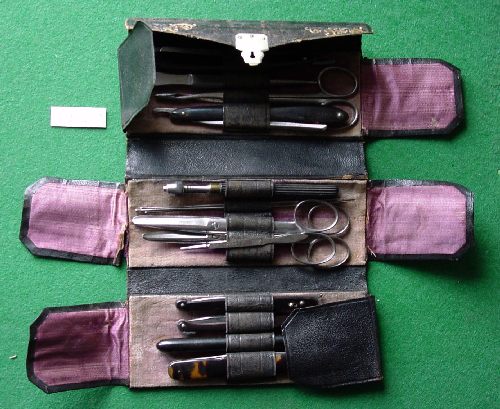 |
| Tasche, um 1880 |
Tweezers
Although the ancient Romans already knew tweezers, especially those for epilation, the instrument was later abandoned. FALLOPIUS, EUSTACHIUS, but also VESAL would have to have used it again, even though it was first shown by VIDIUS (Adam Politzer, History of Otolaryngology, Stuttgart 1907, p. 123).
In the middle of the sixteenth century, the tweezers appeared on the instrument table of the Florentine Vidus Vidius (1509-1569), also known as Guido Guidi, drawn by Francesco Salviati (Chirurgia e Greco in Latinum conversa, 1544).
Bistouri
The name "bistouri" for the surgical scalpel derives from the northern Italian city of Pistoia, where Pistoia's, small sword, has been made from time immemorial. PARÉ (1510-1590) spoke for the first time of the "Bistorie".
The name "scalpel" derives from the Latin "scalpere", cutting, scratching, scraping and is related to the term "sculpture". The German word "scalp" for the hairy scalp, however, derives from the Old Norse "skalli" for the bald head.
Small pocket (French giberne de chirurgien)], touched:
2 razors MONGIN / Marseille
1 tweezers MONGIN
1 clamp (no make)
_________________________
Probe holder (no make)
3 probes
2 scissors (bent, straight), MONGIN
1 hair tweezers (no make)
__________________________
2 scalpels, (hinged, with lock) MONGIN
1 hellstone marker
1 "Swiss knife" with 4 knives: 2 rounded, 2 pointed.
A Henri Mongin (* after 1766 in Crepey, died before 1843), son of a Henri Mongin and Cathérine Perdouche, married in 1791 in Saint Benoît a M.-Antoinette Naze. Whether he is the wanted company founder, I can not say. In any case, the company Mongin was founded in 1814 by a certain Nicolas Mongin and since then has been making knives - it is now part of a larger group called "Groupe Mongin", in which the companies FAURE, GRINCOURT, LUM and SAOTM are combined.
Nota: similar cases were copied by many traders, so the company FAVIER in Paris, r. de la Faculté de Médecine.
|




